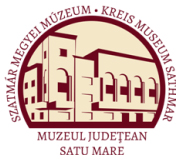Virag, Cristian: Situl neolitic Halmeu - Vamă (Satu Mare, 2015)
Abridged version
depth of 0.96 m (fig. 123, 124). The feature revealed a rich archaeological material represented by pottery, lithic materials and cultic pieces. The feature is Neolithic. The ceramic material is of high quality, scoured with sand and chaff or sometimes with mud. It has a soapy exterior consistency, brick red, yellow-brick or dark brown in colour. Materials are both painted and incised. The ceramic forms are of the kind to be found in the final phase of the Pişcolt group as well as of Iclod I type. The lithic material consists of chipped pieces, polished axes and fragments of querns. Two fragments that belonged to some idols were discovered. The first belonged to an anthropomorphic idol and the second is a taurine horn of a zoomorphic statuette. Cx. 3/1, Cx. 3/2, Cx. 3/3 In the vicinity of Cx. 3 were found three postholes called Cx. 3/1, Cx. 3/2, Cx. 3/3, two on the northern side (Cx. 3/1, Cx. 3 /2) and one on the southern side of the feature (Cx. 3/3), in the excavation profile. Cx. 3/1 and Cx. 3/2 are symmetrical and we can assume the existence of another posthole on the southern side of the feature; Cx. 4 has a turned backwards ”E” shaped form being a trench, captured in the southern part of the profile within the investigated area and representing a foundation trench for a wall (fig. 123,124). The fill was dark brown, it had straight walls and flat bottom. The feature was 0.40 to 0.50 m deep. The feature revealed a few Neolithic pottery and scattered daub; Cx. 4/1 is a small, oval-shaped ditch, with a length of 0.50 m and a width of 0.20 m, obviously correlating with Cx. 4 (fig. 123). The fill was dark brown with oblique walls and a slightly alveolate bottom. No ceramics were found but only scattered daub with an identical filling with the one of Cx. 4; Cx. 5 was a circular pit with a diameter of 1.80 m, bell-shaped walls, and a slightly alveolate bottom (fig. 123, 124). The fill was dark brown with scattered daub. The feature revealed a rich archaeological material like pottery and lithic material; The ceramic material is high quality, scoured with sand and chaff or sometimes with mud, with a more soapy exterior consistency, brick red, yellow-brick or dark brown in colour. Materials are both painted and incised. The ceramic forms are of the kind to be found in the final phase of the Pişcolt group and of the Iclod I type. The lithic material consists of chipped pieces and fragments of polished axes; Cx. 6 was a small, round pit, with 0.40 m in diameter that was partially captured in the southern profile of the researched area (fig. 123). The fill was dark brown, the walls oblique and the bottom slightly alveolate. The feature revealed few Neolithic pottery and scattered daub. The feature is Neolithic; Cx. 7 was a straight ditch, 3.10 m long and 0.40 m wide, representing a foundation trench for a wall. Its maximum depth was 0.40 m (fig. 123, 124). The fill was dark brown, the walls straight and the bottom flat. The feature revealed few Neolithic pottery and scattered daub. The feature is Neolithic. Cx. 2, Cx. 4, Cx. 7 are obviously linked being substantially parallel and of the same size. They represent foundation trenches for the walls of a surface building. Cx. 5 was a storage pit within this structure. Cx. 3 was parallel with the surface structure. The architectural element was closed by Cx. 1, which was oriented similar to Cx. 2, Cx. 4, Cx. 7, but on the direction of Cx. 3. Since Su X / 2014 was positioned in the direction of the fortification ditch, we can assume that these features form the gateway into the settlement and the surface construction that consisted of Cx. 2, Cx. 4, Cx. 7 was some kind of a bastion. Moreover, such buildings located on a fortification system are similar to other settlements of the late Neolithic cultural horizon, such as the Iclod group. Abriged version 91
